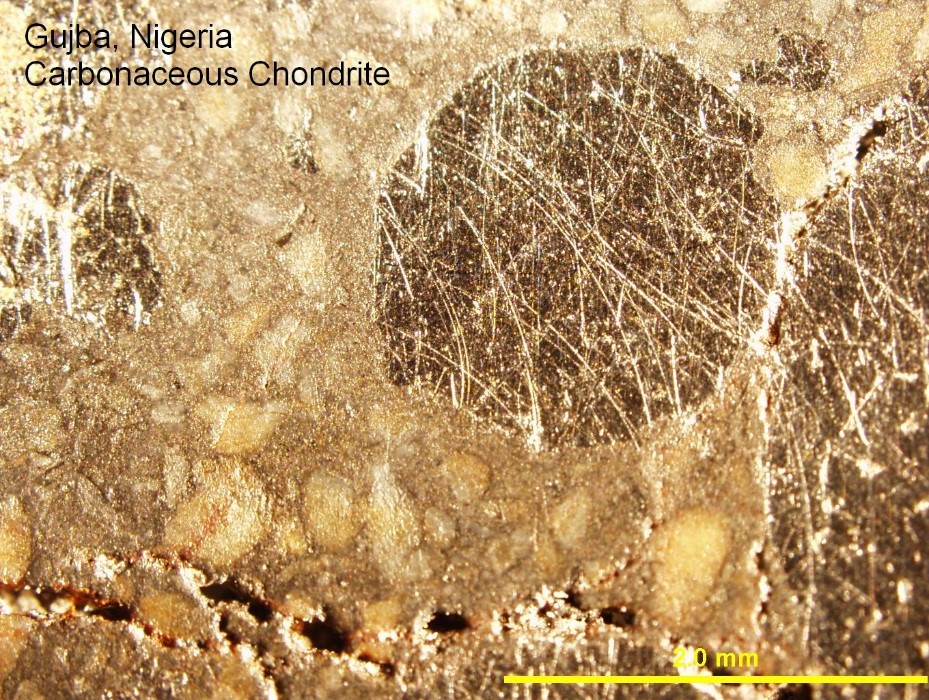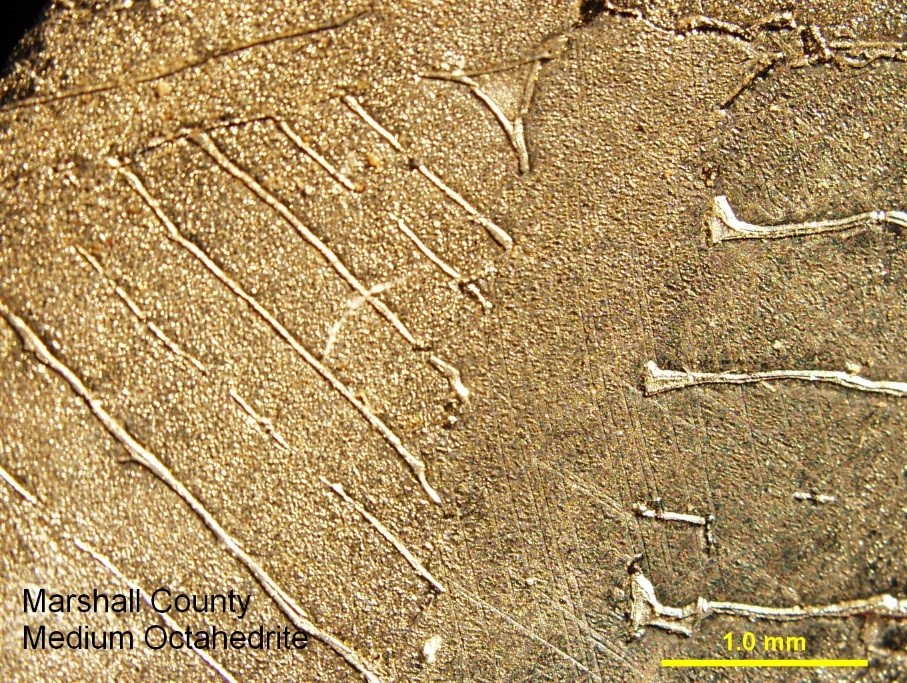Kentucky Geological Survey Meteorite Database
Readme First
To view this Meteorite Interactive Tour, the user can zoom in or out of the map display by using the menu on the map display. It has zoom functions to display the meteorite locations at various scales, and by clicking the top left of the map display the user can change the scale of map that he is examining. The default map image is the world map and by zooming in to the USA and Kentucky, the user can view each meteorite in the state. By clicking on a site location or meteorite image on the screen, more detailed information will be displayed about each meteorite. The database of information provides data on the meteorite name, classification, weight, date found, KGS ID, and where other locations of the primary meteorite are displayed. A reference is also available if the user wants to conduct more detailed research. Unless stated otherwise, each meteorite is on display at the Kentucky Geological Survey's office on the main campus of the University of Kentucky in Lexington.
Launch
The Kentucky Geological Survey has acquired a large collection of meteorites over the past two decades from the generous donations of William D. Ehmann, Lexington, Ky., and William and Mary Ann Russell, Louisville, Ky. Dr. Ehmann was a research geochemist and professor of chemistry at the University of Kentucky and was one of the first researchers to analyze the Apollo 11 moon rocks in 1969. He obtained numerous Kentucky meteorites as part of his research, which he donated to KGS in 1999, shortly after his retirement from UK. At the request of KGS, Dr. Ehmann co-authored a book on meteorites in Kentucky entitled “Space Visitors in Kentucky: Meteorites and Meteorite Impact Sites in Kentucky.” The Russells were lifelong collectors of meteorites, and amassed a large collection of rare meteorites, which they donated to KGS in 2013. Because Mr. Russell had a desire to collect and study these meteorites, they decided to donate their collection to KGS for the benefit of students, faculty, and researchers in meteoritics. In addition, the KGS mineral and meteorite collections are visited by thousands of people annually, and these collections serve to educate the general public about these rocks called meteorites.
The KGS collection is an excellent representative sampling of meteorites derived from our solar system. The collection has more than 230 specimens collected from every continent, including many meteorites found in Kentucky. Several Kentucky meteorites are not represented in the KGS collection, but are on display at major museums around the world, but information about them is included in the KGS database for reference.
The meteorites in the KGS collection are on display in the foyer and on the second floor of the Mining and Mineral Resources Building on the main UK campus in Lexington. Each meteorite has been photographed, cataloged, and inventoried for inclusion into the KGS database. This Interactive Tour gives specific information on location, weight, classification, year found, and a brief annotation of each meteorite in the KGS database. Other museums that display the specimen and a reference list are also provided if you would like to continue research and look for more advanced information. The KGS collection consists of small and large pieces of the original meteorites, and many of the Kentucky meteorites that are not in the KGS collection are on display at the Chicago Field Museum, American Museum of Natural History in New York, the Smithsonian Institution in Washington, D.C., the Center for Meteorite Studies at Arizona State University in Tempe, and the London Museum of Natural History; they are discussed in “Space Visitors in Kentucky: Meteorites and Meteorite Impact Sites in Kentucky” (Ehmann and Anderson, 2000).
Meteors occur in parts of the asteroid belt of the solar system and are called meteorites once they come into contact with Earth. Meteorites fall to Earth by two primary mechanisms:
- In the asteroid belt between Mars and Jupiter, collisions between asteroids and meteors cause some of them to be directed toward Earth, where they can be captured in Earth’s gravitational field and pulled to the planet’s surface
- Planetary impacts can cause ejecta to be thrust into the planetary orbit around the sun, and if the ejecta come into close proximity to Earth, they are captured and can fall to Earth’s surface.
Some meteorites have been analyzed and determined to be from the moon or Mars. Meteorites can be very large and leave impact sites wherever they land in the world, and some are thought to have caused mass extinction events. Weathering and erosion hides traces of most impact sites on Earth, but the moon is pockmarked with evidence of hundreds of meteorite impacts, because there is limited weathering and erosion on the moon.
Meteorites are basically classified as stones (chondrites and achondrites; Fig. 1), irons (metallic; Fig. 2), and stony irons (pallasites; Fig. 3). More complex classifications are described in Ehmann and Anderson (2000) and from the following meteorite classification chart (Fig. 4).
Stone meteorites have a fusion crust, are composed of silicate minerals, and may contain chondrules (spheroidal mineral grains) (Fig. 1) and metallic inclusions. They comprise about 85 percent of observed meteorite falls. Achondrites do not contain chondrules, closely resemble terrestrial rocks, and are the most difficult to identify.
Metallic irons are composed of two interlocking iron-nickel minerals, kamacite and taenite, which form a pattern of interlocking crystals called a Widmanstatten pattern (Fig. 2). The Widmanstatten pattern makes iron meteorites easy to identify when the meteorite is polished and etched. Some metallic meteorites contain troilite, an iron sulfide that occurs in rounded, spherical shapes. Many metallic meteorites do not contain a fusion crust.
Stony-iron meteorites (pallasites) can be some of the most beautiful, as shown in Figure 3. Pallasites are composed of the metallic minerals kamacite and taenite, and stone minerals such as olivine, which exhibits a pretty, yellow-green coloration when the pallasite is cut and polished. Pallasites are very rare meteorites, representing only about 1 percent of falls, and can be some of the most valuable.
Twenty-seven meteorites have fallen in Kentucky and most of them are on display in the foyer of the Mining and Mineral Resources Building. The earliest known Kentucky meteorite was found in Smithland, Livingston County, around 1840, and the most recent was found at Burnwell, Pike County, in 1990 and was collected and identified by the Smithsonian Institution. Some of the meteorites in the KGS collection are rare and have been studied to help in understanding the formation of the solar system and planetary bodies. The Murray carbonaceous chondrite from Calloway County is unique because it contains gases and amino acids that do not occur on Earth. This meteorite has been used in research to determine the extraterrestrial, pre-solar system cosmos chemistry. In addition to the Murray meteorite, several of the metallic meteorites, including those from Campbellsville, Clark County, and Kenton County, contain excellent Widmanstatten structures. These meteorites, along with the unique Eagle Station pallasite from Carroll County, have been used for scientific research.
Identification of meteorites is a common concern for researchers, since many manmade metallic alloys can look like meteorites. Because most meteorites have a high nickel (greater than 5 percent) and iridium content, the nickel test is done frequently to determine if a rock is a meteorite. Many manmade materials also contain nickel, however, so much expertise is needed to determine if a rock is a meteorite. Regmaglypts (thumb-like patterns caused by atmospheric ablation) and the Widmanstatten patterns are distinctive identifying markers used for confirmation of iron meteorites, and chondrules can confirm stony meteorites. More information on meteorite identification and Kentucky meteorites is available in Ehmann and Anderson (2000).
The following chart describes the classifications of the meteorites in the KGS collection. Meteorites are of three basic types: stones, irons, or stony irons.




